History
The house began as a modest timber-framed farmhouse constructed for John Fetherston between 1556 and 1560. The last member of the Fetherston family died in 1876. [3] In 1904 the house was purchased by Birmingham industrialist Alfred Ash. [4] It was inherited by Graham Baron Ash (Baron in this case being a name not a title) in 1925, [3] who spent the following two decades creating a house of Tudor character. He purchased an extensive collection of 16th- and 17th-century furniture, some obtained from nearby Baddesley Clinton. The great barn of the farm was converted into a Tudor-style hall with sprung floor for dancing, and was connected to the main house by the addition of a Long Gallery in 1931. [5]
In 1941, Ash donated the house and gardens to the National Trust in memory of his parents but continued to live in the house until 1947 when he moved to Wingfield Castle. [6]
Gardens
The famous Yew Garden containing over 100 trees was laid out in the mid-17th century by John Fetherston, the lawyer. The clipped yews are supposed to represent "The Sermon on the Mount". Twelve great yews are known as the "Apostles" and the four big specimens in the middle are 'The Evangelists'. A tight spiral path lined with box hedges climbs a hummock named "The Mount". The single yew that crowns the summit is known as "The Master". The smaller yew trees are called "The Multitude" and were planted in the 19th century to replace an orchard. [4]
The Yew Garden is entered by raised steps and a wrought-iron gate. The garden path follows an avenue of trees, which leads up a spiral hill [1] where a wooden seat is placed beneath a yew tree. This vantage point provides views of the house and the Yew Garden. [5]
Some of the yews at Packwood are taller than 50 feet (15 m). [7] The soil on the estate has a high level of clay, which is detrimental to the trees during wet periods. As a result, parts of the garden are often closed to the public while restoration work is undertaken [7] The house and gardens are open to the public throughout the whole year as of 2013. [8]

The West Midlands is one of nine official regions of England at the first level of International Territorial Level for statistical purposes. It covers the western half of the area known traditionally as the Midlands. The region consists of the counties of Herefordshire, Shropshire, Staffordshire, Warwickshire, West Midlands and Worcestershire. The region has seven cities: Birmingham, Coventry, Hereford, Lichfield, Stoke-on-Trent, Wolverhampton and Worcester.

Alcester is a market town and civil parish in the Stratford-on-Avon District in Warwickshire, England. It is 8 mi (13 km) west of Stratford-upon-Avon, and 7 miles south of Redditch. The town dates back to the times of Roman Britain and is located at the junction of the River Alne and River Arrow.

Edgbaston is a suburb of Birmingham, West Midlands, England. It lies immediately south-west of Birmingham city centre, and was historically in Warwickshire. The wards of Edgbaston and North Edgbaston had a combined population of 42,295 at the 2021 census.

The Metropolitan Borough of Solihull is a metropolitan borough in West Midlands county, England. It is named after its largest town, Solihull, from which Solihull Metropolitan Borough Council is based. For Eurostat purposes it is a NUTS 3 region and is one of seven boroughs or unitary districts that comprise the "West Midlands" NUTS 2 region. Much of the large residential population in the north of the borough centres on the communities of Castle Bromwich, Kingshurst, Marston Green and Smith's Wood as well as the towns of Chelmsley Wood and Fordbridge. In the south are the towns of Shirley and Solihull, as well as the large villages of Knowle, Dorridge, Meriden and Balsall Common.
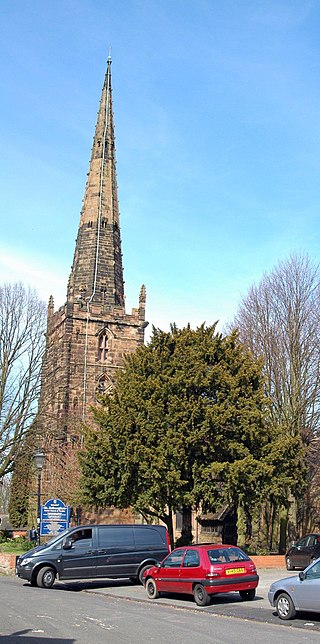
Yardley is an area in east Birmingham, in the county of the West Midlands, England. It is also a council constituency, managed by its own district committee. Historically it lay within Worcestershire.

New Place was William Shakespeare's final place of residence in Stratford-upon-Avon. He died there in 1616. The whole building was demolished in 1702 by Sir John Clopton, who replaced it with a modern-style house, also called New Place. This in turn was demolished by Francis Gastrell, vicar of Frodsham, Cheshire, in 1759. It was never rebuilt after the second demolition and only the foundations remain.
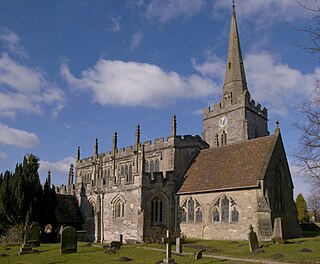
Lapworth is a village and civil parish in Warwickshire, England, which had a population of 2,100 according to the 2001 census; this had fallen to 1,828 at the 2011 Census. It lies seven miles (11 km) south of Solihull and ten miles (16 km) northwest of Warwick, and incorporates the hamlet of Kingswood. Lapworth boasts a historic church, the Church of St Mary the Virgin, a chapel. Two National Trust sites are nearby: Baddesley Clinton, a medieval moated manor house and garden located in the village of Baddesley Clinton; and Packwood House, a Tudor manor house and yew garden with over 100 trees in Packwood.
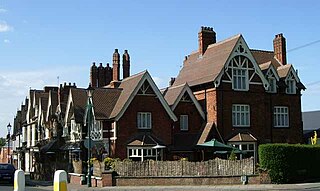
Dorridge is a large village in the Metropolitan Borough of Solihull in the West Midlands (county), England. Historically part of the historic county of Warwickshire, the village is encompassed within the electoral ward of Dorridge and Hockley Heath, which had a population of 11,140 in the 2011 census.
Keresley is a suburban village and civil parish in the City of Coventry, West Midlands, England, about 4.5 miles (7 km) north of Coventry city centre and 3.5 miles (6 km) southwest of Bedworth. According to the 2001 census, the parish had a population of 791 falling to 713 at the 2011 Census, although the 2018 population was estimated at 783.

Allesley is a suburban village and civil parish in the City of Coventry metropolitan borough, West Midlands, about 3.5 miles west-northwest of Coventry city centre and 4 miles (6.5 km) east-south-east of Meriden. Located in the Arden area of historic Warwickshire, the parish population according to the 2001 census was 805, which rose to 837 at the 2011 census, and as of the 2021 census, the population was 908. Until 1998, Allesley contained the main Jaguar car assembly plant at Browns Lane.

Hockley Heath is a village and civil parish within the Metropolitan Borough of Solihull, West Midlands, England. The village is to the south of the West Midlands conurbation, 12 miles (19 km) southeast of Birmingham 5.5 miles (8.9 km) from Solihull town centre and 13 miles (21 km) north of Stratford-upon-Avon. Hockley Heath is in the Arden area and borders Warwickshire and the District of Stratford-on-Avon to the south, with some parts of the village on either side of the border. It incorporates the hamlet of Nuthurst, and has a history dating back to the year 705 AD as a wood owned by Worcester Cathedral. The 2011 Census gives the population of Hockley Heath civil parish as 2,038.
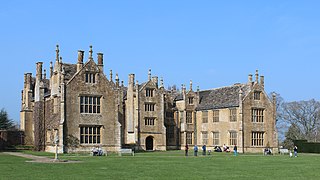
Barrington Court is a Tudor manor house begun around 1538 and completed in the late 1550s, with a vernacular stable court (1675), situated in Barrington, near Ilminster, Somerset, England.

Cherkley Court, at the extreme southeast of Leatherhead, Surrey, in England, is a late Victorian neo-classical mansion and estate of 370 acres (1.5 km2), once the home of Canadian-born press baron Lord Beaverbrook. The main house is listed Grade II on the National Heritage List for England.
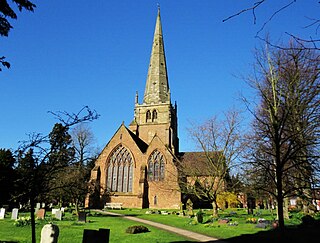
Solihull is a market town and the administrative centre of the Metropolitan Borough of Solihull, in the West Midlands, England. Solihull is situated on the River Blythe in the Forest of Arden area. The town had a population of 126,577 at the 2021 Census, and its wider borough had a population of 216,240. The town is located 8 miles (12 km) southeast of Birmingham and 14 miles (21 km) west of Coventry.

Coundon Court is an all-inclusive Academy in Coundon, Coventry, England. The Headteacher is Chris Heal.

Chapelfields is a suburb of Coventry, West Midlands, England. It is situated about 1.5 miles to the west of Coventry City Centre; bordering Coundon to the north, Earlsdon to the south, Spon End to the east and Whoberley to the west. It is mainly residential, with a high proportion of graduates among the younger residents, and nowadays a significant element of students, particularly those studying at the University of Warwick. Houses in Chapelfields proper are mostly small to medium-sized terraced houses with gardens.

The Florence Court Yew is the surviving specimen of the two original Irish yew seedlings. As such, it is the oldest Irish yew alive and it is believed that almost all Irish yews worldwide descend from this specimen. It is located in Florence Court demesne in County Fermanagh, Northern Ireland and is cared for by the National Trust.

Trinity House was a small country house in the village of Allesley, Coventry in the West Midlands, formerly the county of Warwickshire. It stood at the end of Rectory Lane immediately north-west of All Saints Church on the crest of the hill between the River Sherbourne and Pickford Brook. The house became one of "the lost houses" of England after being demolished in the mid-1960s as part of the wider destruction of country houses in 20th-century Britain.

























